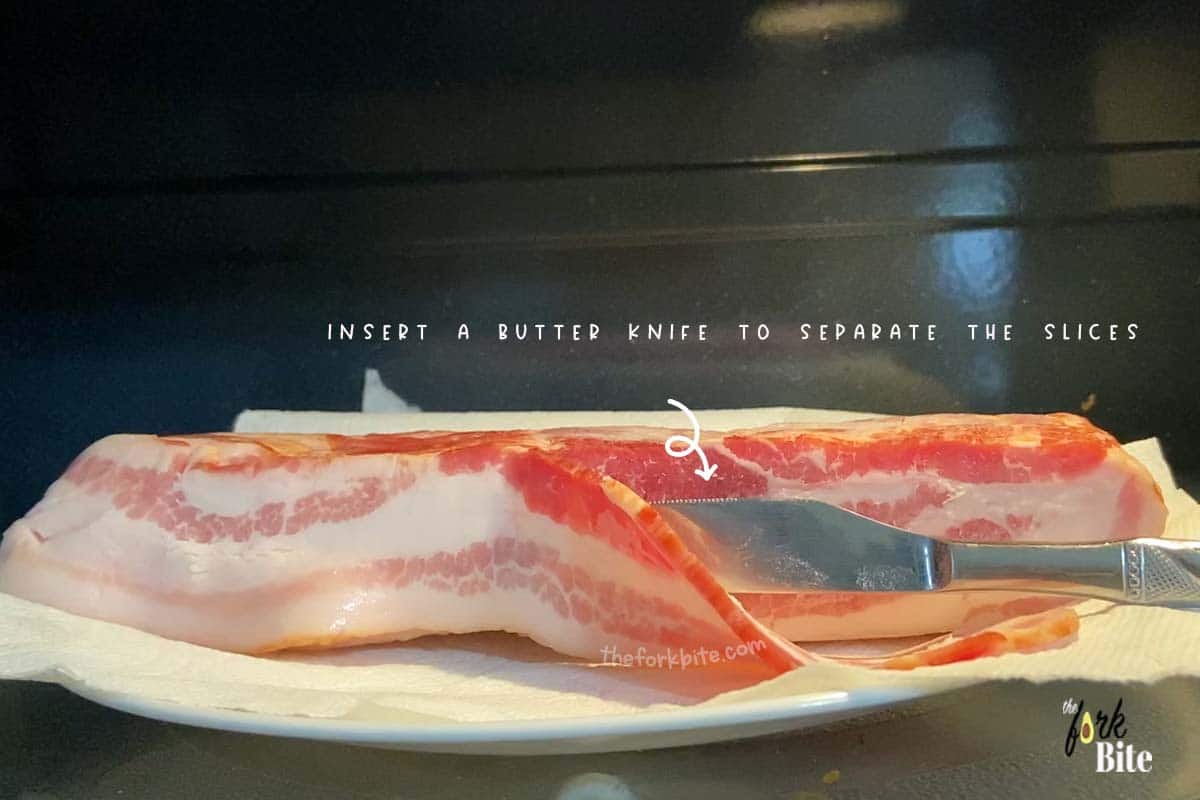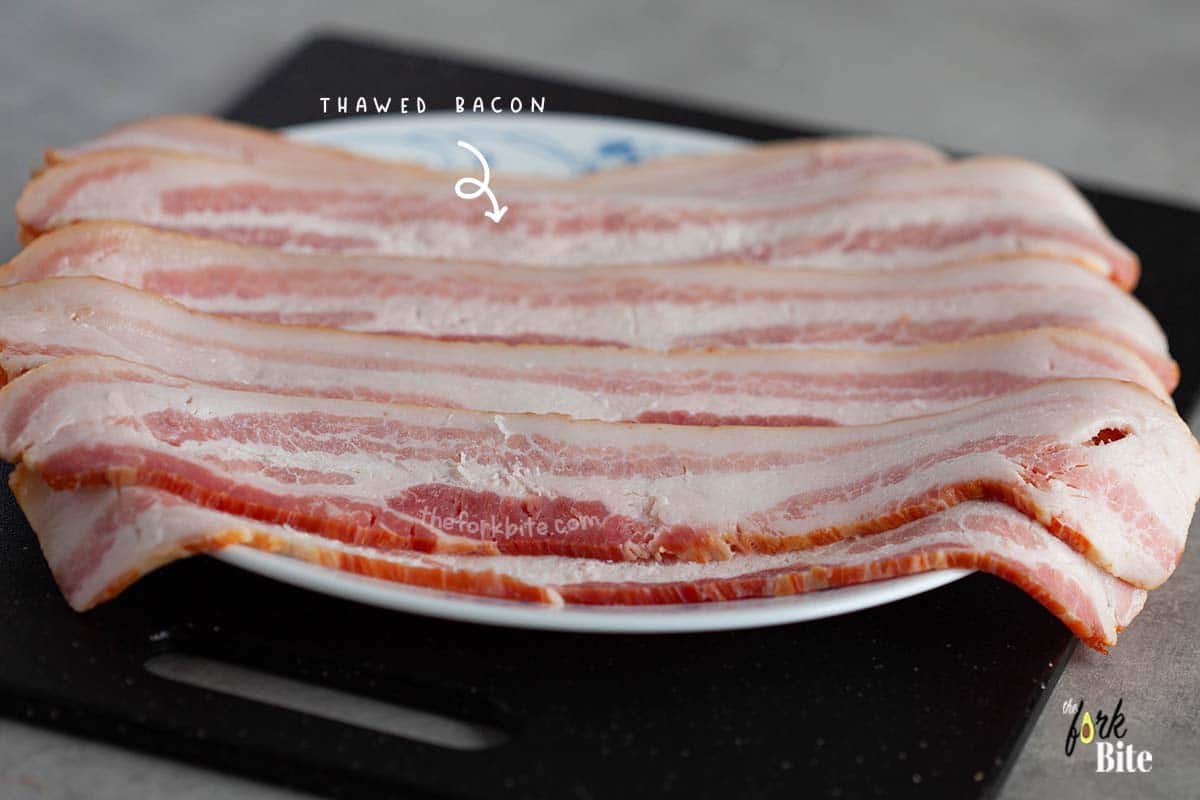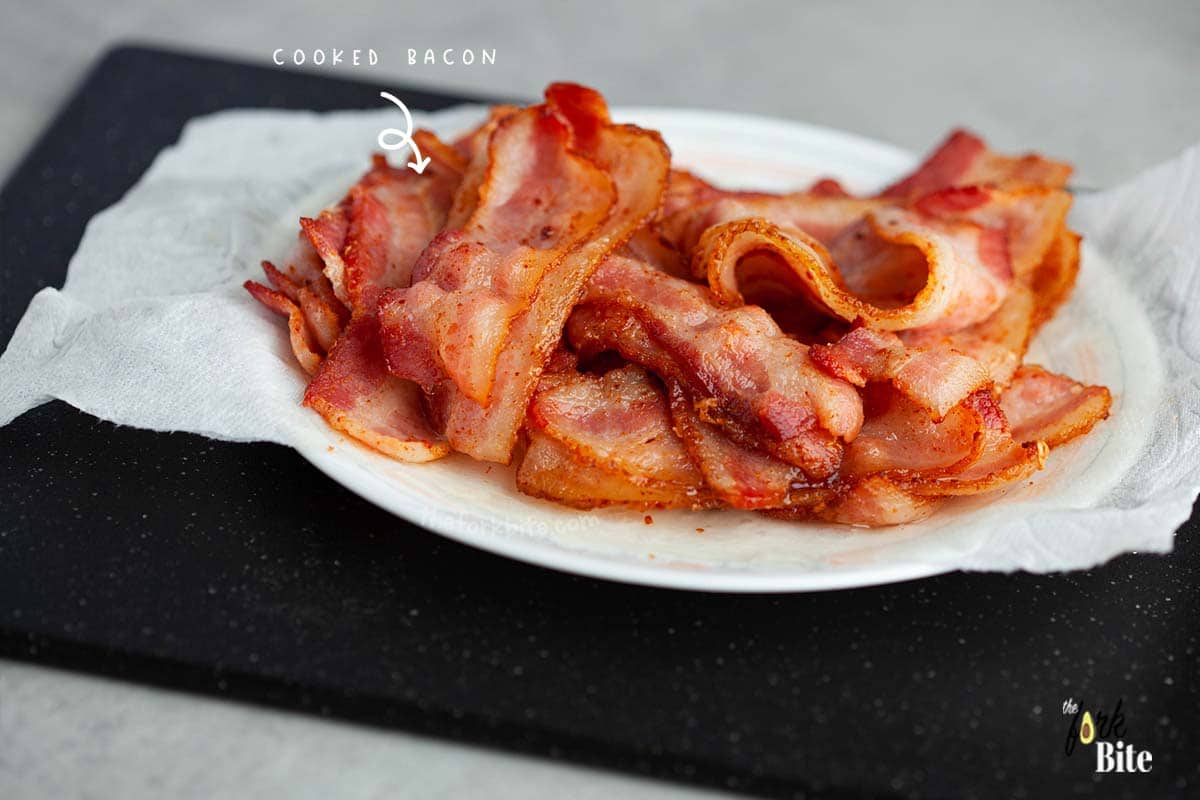If you and your family adore bacon as much as me and mine, you ought to consider buying it in bulk, freezing it, and defrosting it for when the craving for a rasher or two gets too much to bear.
Perhaps you already have considered it but haven't gone ahead because you think it will lose too much flavor in the process?
If that is the case, I have some good news for you. I can tell you the best way to freeze your porky treat and defrost it, so it doesn't harm the taste or the texture.
The good part is that you can defrost it in your microwave, so it only takes an instant. Interested? - if so, please read on.
Jump to:
How to defrost bacon in your microwave
- The first thing you must do if you're going to defrost frozen bacon in your microwave is to adjust the appliance's setting to "defrost."
If you try and defrost it on full blast, the bacon will begin to cook, and it will become dry and rubbery. Setting your microwave to defrost is the key.
- Transfer the frozen bacon from your freezer onto a microwave-safe plate and defrost for 60 seconds.
- When you hear the "ping," flip the rashes over, move them around on the plate and carry on defrosting for a further 60 seconds or until the bacon is being thawed.
But there are a few tricks I'd like to share with you to ensure you get the perfect results every time. So let's get started.
Things to know before defrosting bacon
If you're an old hand in the kitchen, you may already be aware of the fact that you can defrost bacon in your microwave.
But if you're a kitchen newbie or someone who doesn't like to experiment, you may not be aware that you can, and it's these guys to whom I pose the question.
If you were to try to cook frozen bacon straight from the freezer, not only would it take much longer than if you were to defrost it in your microwave first, but it's not likely to cook evenly.
As for getting it crispy - forget it - unless you like your bacon cremated. So, it's essential to defrost it first before you cook it.
Is it safe to defrost bacon first?
It's a good question, and the answer is yes, it's perfectly safe. The only provisos are that you mustn't leave it hanging around too long at room temperature before you cook it, and you must not refreeze bacon once it's been defrosted.
That would be unsafe, as you can see if you read this question and answer session on the USDA website.
So, yes, you can defrost bacon in the microwave if you follow the above-given recommendations and observe the precautions.
- If you are defrosting bacon that is still in its original shop-bought packaging, you need to make a few holes in the wrapper using a fork. It is important because it will vent the pack and allow any steam to escape. If you don't do it, the package could explode.
- Defrost in short bursts - for example, 60 seconds at a time. If you set the timer too long and forget about it, any steam that builds up will cause the bacon to start cooking.
- Another thing is that if microwaved for too long, the plastic wrapper could start to melt. It's unlikely on a "defrost" setting, but if left on for too long, it could happen after a few minutes. Melted plastic can be hazardous to health if eaten accidentally.
Does the texture get affected after defrosting?
The texture of bacon defrosted in your microwave will not be detrimentally affected, providing it is defrosted at the right time relating to its weight.
If you try to thaw it very aggressively on a high heat setting, you can affect bacon's taste and texture in the wrong way.
You have to bear in mind that the object of the exercise is to defrost frozen bacon and not cook it.
To achieve the best results, you need to separate the rashers to allow each one to thaw in its own right rather than trying to defrost it in an unseparated block.
How long does it take to defrost bacon?
On average (about 1.5 lbs), defrosting bacon in your microwave takes less than 3 minutes.
However, it is important to use your microwave's defrost setting, or if it doesn't have one, to reduce its power level.
If you use your microwave on a "normal" setting, the outside of the bacon will burn, while the inside will remain frozen.
The defrost setting on a microwave essentially lowers the appliance's power level, allowing the food you are exposing to the microwaves to defrost gently rather than cooking it.
You can defrost it in this way, either still in its original store-bought packaging or without.
The weight of the bacon you wish to defrost is important as it will directly affect the length of time it needs to defrost.
You will need to use your kitchen scales to determine the weight of the bacon, which I will explain further in due course.
The best way of defrosting bacon quickly
You will find that many people recommend defrosting bacon by putting it into the fridge and keeping it there overnight.
Admittedly this works well. The problem comes when you need to defrost it quickly, and this is where your microwave can save the day.
If you observe the steps below, you can defrost up to 1.5 pounds of frozen bacon in less than 2 to 3 minutes.
Step 1
Take the bacon out of the freezer, remove it from its packaging, and wrap it in a paper kitchen towel.
The paper towel serves two purposes.
- Firstly it will absorb any liquid or fat that is drawn from the bacon as it defrosts.
- Secondly, it will help to prevent the bacon from losing too much moisture.
Step 2
Select the "defrost" setting on your microwave, or if it doesn't have one, reduce the power setting to approximately 30%.
Step 3
Transfer the bacon onto a microwave-safe plate or dish, place it into the microwave, close the door, and press start.
Step 4
If the bacon is still clumped together, straight from the packaging, let it defrost for approximately two minutes (I was defrosting 1.5 lbs and it took me about 3 minutes using 60 seconds burst), after which you can separate the rashers.
When it feels semi-thawed after 60 seconds, it's time to flip it over and carry on defrosting. You can do this as often as it feels right, but be careful not to allow it to begin cooking.
Carefully insert its dull edge down the length between each rasher, gently rocking the blade and thereby separating the slices.
Step 5
Place the thawed bacon on a separate plate. It is vital to microwave in short bursts, say 60 seconds at a time. It will allow you to judge how the thawing process is progressing.
Step 6
As soon as the rashers have thawed through completely, it's time to cook them. Don't leave defrosted bacon hanging around for too long before cooking it because that can allow bacteria to start forming.
Pros and cons
Pro
The quickest way possible of thawing bacon and can get you out of a tight corner when needed.
Con
If microwaved for too long or on a too-high power setting, the bacon will begin to cook, and the final cooked product could end up tough and dry.
Related: How to Quickly Thaw Bacon
More tips on defrosting bacon in a microwave
Don't forget that you should cook it straight away if you defrost frozen bacon in a microwave.
Whatever you do, do not refreeze it because the chances are harmful bacteria would develop, contaminating the meat.
Here are some following tips:
- Pre-portion before freezing
Pre-portioning bacon before you freeze makes it a cinch later when you only want to cook a few slices rather than the entire pack.
Trying to separate it into individual rashers once it's frozen is a nightmare.
When you get it back home from the store, the rashers are easy to separate.
So to make life easier later on, open the pack, divide the rashers into the portion sizes you will be cooking
- wrap each serving in aluminum foil, or pop into Ziploc freezer bags.
Some suppliers tell you on the packaging to freeze the pack unopened.
That's all very well if you will be cooking the whole thing. But it's not helpful if you will only be cooking it a few rashers at a time.
Remember, it's not recommended to defrost the whole pack; take what you need and refreeze the rest. That could be the road to food poisoning.
Different types of microwaves
Many microwaves sold today are preprogrammed to cook or defrost by weight. It is designed to make it easier to get the timing right. If you want to make use of this feature, you will have to weigh the bacon first.
You can either do so using your kitchen scales or, you can "guestimate" by how much of the pack you want to apportion.
The packaging will have the weight of the bacon printed on it. So, if you want to portion size it into quarters, simply divide the total weight by four.
Remember, if your microwave has a defrost setting - use it. If it has a power setting - reduce it to 30%.
Timing is key
If your microwave doesn't have a cook by weight feature, revert to the time guide I mentioned earlier - namely five minutes per pound.
You can still do the guestimation by dividing the time per pound by the rough portion size.
So for half a pound of bacon, divide by two, and you arrive at two and a half minutes. Don't forget to flip the bacon over halfway through the thawing time.
Talking about flipping the bacon over, some microwaves are programmed to ping or beep at set intervals.
If yours does this, it is a reminder to flip and reposition whatever you are cooking or defrosting. If it's bacon, don't forget to cover it again with a paper kitchen towel.
Most models of microwaves have revolving turntables. If yours doesn't, you need to turn the dish a quarter turn each time you restart the defrosting process.
If you are using the appliance's manual setting, you won't get an automated reminder, so you must remember yourself.
Cooking defrosted bacon in your microwave
Having defrosted the bacon, you can now get on with the actual cooking, and if you want to use your microwave, please feel free.
First things first, throw away the old, used kitchen towel, and replace it with new. Reposition the rashers on top, and then cover them with kitchen paper.
How did we get by before they invented the kitchen towel? It's so damned useful.
- You want to allow a minimum of 30 seconds of cooking time per slice. If you accidentally over-thawed the bacon, you can reduce the cooking time accordingly.
- Once cooked, you should allow the bacon to rest for five minutes before serving.
- Don't forget that microwaved food carries on cooking for a little while after the appliance stops, so adjust your timing to suit.
Reheating cooked bacon
Now I agree that this might seem rather alien. Who leaves cooked bacon on the plate?
But just for argument's sake, say aunt Gabby rang as you were just about to tuck into your gorgeous cooked bacon, and you couldn't stop her waffling on for twenty minutes.
The bacon or aunt Gabby? I know it's a difficult choice, but let's say that family respect won the day.
Okay, so you've done your good deed for the day, but now, how do you get back on with the serious business of reheating the bacon?
1 Par-cooking the bacon to finish off later
It could be that aunt Gabby is a regular interruptor of breakfast, or it might also be the case that you want to plan ahead so that when you fancy a bacon fix, you don't have to wait too long while it cooks.
Answer? - par-cook it.
Many people like their bacon crispy, but if you prefer yours still a bit soft, moist and chewy, you can still par-cook it if you're careful.
It's all about par-cooking and stopping just before it reaches your preferred level of doneness (don't forget it will carry on cooking a little anyway, even after you remove it from the heat).
It's technically known as carryover cooking, and although it's more important with bigger pieces of meat, it still affects slices of bacon, too - only not quite so much.
So par-cook carefully, then when the time comes to finish off the cooking, watch it like a hawk, so you don't overdo it.
2 How to store cooked and par-cooked bacon safely
When storing cooked or par-cooked bacon, it essential to keep it in a container with a tight-fitting lid. Alternatively, you can wrap it tightly with aluminum foil.
Following these guidelines, you can store cooked or par-cooked bacon in your fridge for as long as five days. If you want to freeze it, it can last for up to three months.
With frozen cooked or par-cooked bacon, I recommend defrosting it overnight in your fridge rather than using the microwave.
3 Reheat bacon in the oven
If you're thinking about reheating bacon in the oven, it's not a bad idea providing you keep a careful eye on it.
To save on washing up, or at least to make it a little easier, I recommend covering the baking pan in which you will cook the bacon with a sheet of aluminum foil.
Follow these steps.
- Preheat your oven to 350°F
- Place the rashers of bacon half an inch apart from each other on the foil layered baking pan and pop into the preheated oven.
The length of time you leave the bacon in the oven will depend on two things.
- How much it was cooked or pre-cooked in the first place.
- How you prefer your bacon - crispy or soft.
Now let's check out reheating it in the microwave.
4 Reheating cooked bacon in the microwave
The only problem with using your microwave to reheat cooked bacon is the speed it takes. It's all too easy to overcook it.
Follow these steps.
- Place the rashers of cooked or par-cooked bacon, half an inch apart, onto a microwave-safe plate lined with a paper kitchen towel.
- Microwave at full power for 10 seconds at a time. After every ten seconds, check to see how it is progressing.
- Frozen or par-cooked bacon will take longer. Keep it to 10-send bursts, but have more of them.
Although it might seem a pain, short bursts are the only way to prevent the bacon from being overcooked.
5 Reheating on the stovetop
The method I am about to impart may seem counterintuitive, but trust me - it works.
Follow these steps.
- Place the rashers of bacon into a frying pan or skillet and add enough water just to cover the bacon.
- Heat until the water boils. Then select a low setting for cooked bacon or medium heat for par-cooked.
The water will evaporate quite quickly, so once again, you need to keep a watchful eye on it.
You will lose a smidgin of the flavor, but it's still a tasty treat and works particularly well for those who like their bacon soft.
How to keep bacon warm
If you need to keep cooked bacon warm for any reason, here's the best way to go about it.
- Place the bacon in a pile (the same principle as bodies huddling together to retain warmth) onto a double thickness of aluminum foil.
- Drape another sheet of foil over the top. You can fold the edges together if you wish to make a pouch. Place onto the top shelf of an oven preheated to 200°F.
The bacon will stay nice and warm, and the pouch will stop the bacon from drying out too much.










